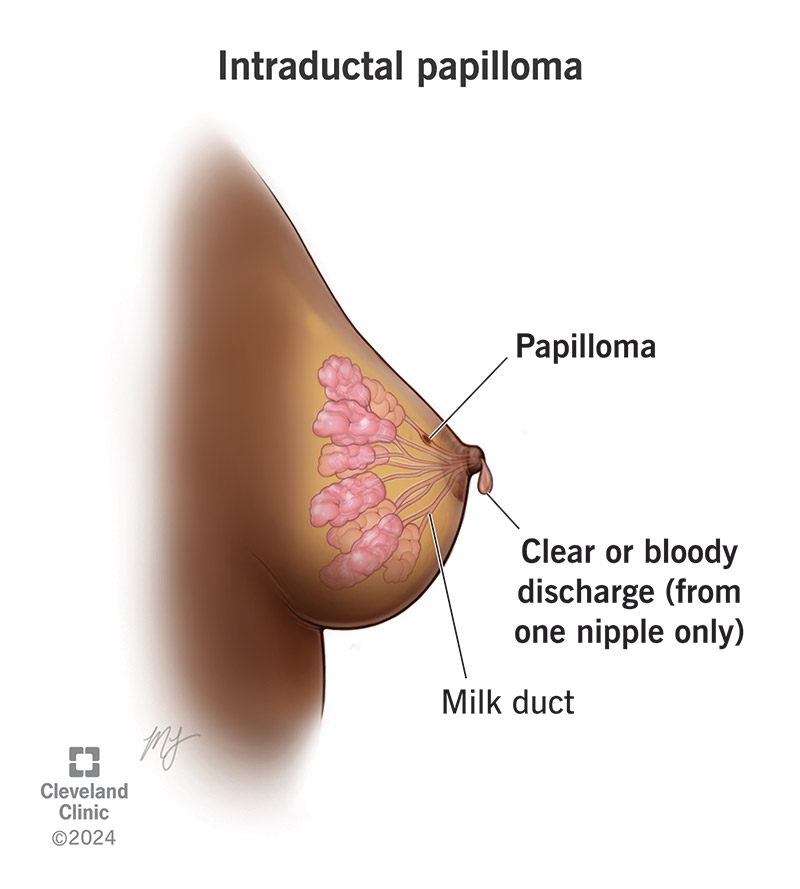Intraductal papillomas are benign (noncancerous) tumors that form in your breast’s milk ducts. Often, they’re asymptomatic. But sometimes, they cause clear or bloody discharge from your nipple. Although it’s rare, these tumors can hide atypical cells that can become cancer. For this reason, providers often recommend surgery to remove them.
Advertisement
Cleveland Clinic is a non-profit academic medical center. Advertising on our site helps support our mission. We do not endorse non-Cleveland Clinic products or services. Policy

Intraductal papillomas are benign (noncancerous) breast tumors in your milk ducts. “Papillomas” are wartlike growths covered in epithelial cells. Epithelial cells cover internal and external surfaces in your body. “Intraductal” just means that the tumors are inside (intra) your milk ducts (ductal).
Advertisement
Cleveland Clinic is a non-profit academic medical center. Advertising on our site helps support our mission. We do not endorse non-Cleveland Clinic products or services. Policy
Although an intraductal papilloma is benign, your healthcare provider will test it to ensure it doesn’t contain atypical cells that could become cancerous.
Types include:
Approximately 10% of benign breast lesions (areas of abnormal or damaged tissue) are intraductal papilloma. Most are solitary papillomas (a single tumor).
Not all papillomas cause symptoms. You may not learn you have a papilloma unless a healthcare provider spots an abnormal area (lesion) during an imaging procedure, like a mammogram.
But some papillomas cause breast changes. Symptoms include:
Advertisement
Contact your healthcare provider if you’re experiencing these symptoms.
Intraductal papillomas form when epithelial cells in your milk ducts overgrow. But experts don’t know what fuels the growth. Research is ongoing to determine what causes intraductal papilloma.
Some people who hear the word “papilloma” assume intraductal papillomas are associated with human papillomavirus (HPV) infections. But there’s no connection. It’s true that some high-risk strains of HPV increase your risk of certain cancers.
But an HPV infection doesn’t cause intraductal papillomas or increase your risk.
Research is ongoing to determine risk factors for intraductal papilloma. Factors that researchers do know may increase your risk include:
Intraductal papillomas aren’t cancerous. Still, your healthcare provider will need to check these growths. Intraductal papillomas are a “high-risk precursor lesion.” This means providers sometimes find cells inside or near papillomas that could become malignant (cancer).
Although it’s rare, providers sometimes find signs of:
Multiple papillomas are more likely to contain atypical cells than solitary papillomas. Multiple papillomas also slightly increase your lifetime breast cancer risk. Researchers are still studying the reasons why.
Still, it’s important to remember that treatments are available that can cure ADH and DCIS.
The only way to diagnose an intraductal papilloma is with a breast biopsy. During a biopsy, a provider removes all or part of the papilloma. Afterward, a pathologist tests it for abnormal cells.
Advertisement
Traditional imaging studies, like a mammogram, ultrasound or magnetic resonance imaging (MRI) may show unusual growths. But without a biopsy, there’s no way to know that the tumors are papillomas.
For example, on a mammogram, an intraductal papilloma may look like a mass, nodule or calcifications. These are signs of many kinds of benign and malignant (cancerous) breast tumors.
Your healthcare provider will need to test the tissue directly to diagnose intraductal papilloma.
Treatment for intraductal papilloma depends on how many tumors you have, among other factors.
Your healthcare provider may recommend monitoring small solitary papillomas that don’t cause symptoms. But most intraductal papillomas need to be removed.
Treatments to remove papillomas include:
Advertisement
Your healthcare provider will explain the best treatment options based on your biopsy results.
Intraductal papillomas aren’t cancerous. Rarely, these tumors can harbor atypical cells that may require treatment. Multiple papillomas may slightly increase your lifetime cancer risk. This means you may need more frequent monitoring for cancer.
The good news is that treatment to remove the cells can prevent atypical or precancerous cells from forming. And if you do have atypical cells, surgery can prevent them from becoming cancerous.
There’s no way to prevent intraductal papillomas. But regular breast cancer screenings allow your provider to keep tabs on your breast health. Scheduling an appointment with your provider at the first sign of breast changes can help, too.
Catching changes early and getting treated can prevent benign breast conditions from ever progressing to cancer.
Questions to ask include:
Advertisement
Intraductal papillomas are benign. But you’ll still likely need treatment or monitoring if you have one or more papillomas. Most intraductal papillomas never progress to cancer, but occasionally they give rise to atypical cells that do. Your biopsy results, the number of papillomas you have and your lifetime breast cancer risk all factor in when it comes to your treatment options. Your healthcare provider will advise you based on your diagnosis.
From routine pelvic exams to high-risk pregnancies, Cleveland Clinic’s Ob/Gyns are here for you at any point in life.

Last reviewed on 03/05/2024.
Learn more about the Health Library and our editorial process.